|
Church of
San Romano Lucca
|
The
Church of San Romano, like many churches in
Lucca and Italy, has a long history full of
anecdotes and characters, unfortunately most of the
time forgotten guilty, unknown to most, even those
who live there a few meters. For at least a couple
of years it has been reopened to the public as a
sumptuous auditorium for various events, from
concerts to book presentations to the most diverse
cultural meetings. Next time you go to this
beautiful former temple, we hope you will recall
some passages from its past.
|
|
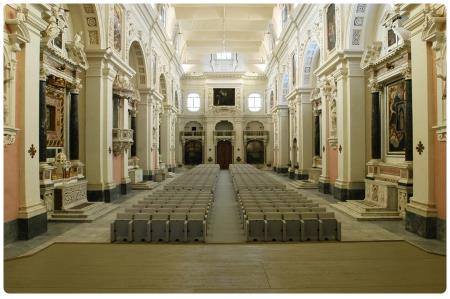 The
Dominican friars took possession of the church in
1236 "there was no doubt that the body of the
Holy Martyr rested in it. When then in 1281, it was
necessary to solemnly transfer the sacred deposit of
the old Church to the one built again, the
inscription was observed in the urn: Hic requiescit
corpus S.Romani martyris, qui babtizatus fuit a
S.Laurentio M.C.XV.VII sexto idus Augusti". (1) The
Dominican friars took possession of the church in
1236 "there was no doubt that the body of the
Holy Martyr rested in it. When then in 1281, it was
necessary to solemnly transfer the sacred deposit of
the old Church to the one built again, the
inscription was observed in the urn: Hic requiescit
corpus S.Romani martyris, qui babtizatus fuit a
S.Laurentio M.C.XV.VII sexto idus Augusti". (1)
Romano (died in Rome, August 9, 258), was a Roman legionary who
converted to Christianity while attending the martyrdom of St. Lawrence.
Declared Christian, he was beheaded at the time of the persecution of the
Emperor Valerian. His relics are in
Rome,
Ferrara
and Avella and Lucca. Curiously he is the patron saint of the
Principality of Monaco.
The construction of the Church of San Romano began in the VII, as a
small oratory within what was once the Castrum of Lucca. In the 13th century
the Dominican Friars began heavy renovation and expansion work, which
led to the building's current form, that is, that of a large church with a
single nave. The project was never completed, however, so much so that the
façade still lacks marble cladding.
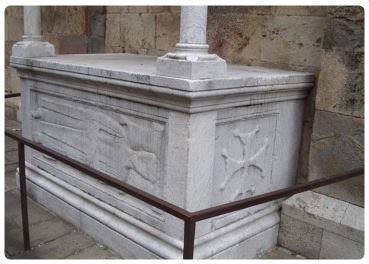 On
the right side, once was the cloister and for this reason there were found
numerous tombstones, from the fourteenth and fifteenth centuries, including
those of seven Teutonic knights. The nearby via Gallitassi was
the place where the Knights Templar had their dependence. Lucca, on
the Via Francigena was in fact a crossroads of pilgrimage to Rome,
and the main monastic and religious orders dedicated to the care and
protection of wayfarers had their own mansion on site. In via Gallittassi
the Knights of Malta took possession of the property of the "Templars"
after their suppression, then in 1799 the State property of Lucca. Today
there are some coats of arms hanging in the adjacent palace and the memory
in the name of the alley of the Cross of Malta, in poor state of
preservation. In the church of San Romano, on 26th April 1413 peace was
signed between Florentines, Genoese and Pistoiese (2). On
the right side, once was the cloister and for this reason there were found
numerous tombstones, from the fourteenth and fifteenth centuries, including
those of seven Teutonic knights. The nearby via Gallitassi was
the place where the Knights Templar had their dependence. Lucca, on
the Via Francigena was in fact a crossroads of pilgrimage to Rome,
and the main monastic and religious orders dedicated to the care and
protection of wayfarers had their own mansion on site. In via Gallittassi
the Knights of Malta took possession of the property of the "Templars"
after their suppression, then in 1799 the State property of Lucca. Today
there are some coats of arms hanging in the adjacent palace and the memory
in the name of the alley of the Cross of Malta, in poor state of
preservation. In the church of San Romano, on 26th April 1413 peace was
signed between Florentines, Genoese and Pistoiese (2).
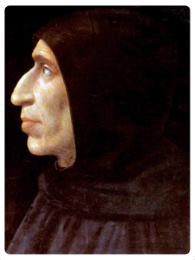 The
Dominican monastery, which in 1325 had hosted Saint Catherine of Siena,
thereat by the Pope to Lucca to trace the devotion of the city to the papacy
in full schism and transfer of the Pope to
Avignon, became an important religious center and hosted, among
others, Fra Girolamo Savonarola. One of Savonarola's first
biographers and dear friend was a Lucchese, Fra Pacifico Burlamacchi,
who took the cassock a year before the death of the friar of Ferrara,
entering the convent of San Romano. Girolamo's brother Marco, who in turn
became Dominican in 1497, known as Fra Maurelio, died in the Convent
of San Romano on 28 December 1510 (3). This place had become the guardian of
Savoie religiosity at the death of the preacher. Although contrary to the
status quo of the church at the time, it was the Dominicans of San Romano
who were "vigorously" opposed to the spread of Lutheran heresy. The
Dominican monastery, which in 1325 had hosted Saint Catherine of Siena,
thereat by the Pope to Lucca to trace the devotion of the city to the papacy
in full schism and transfer of the Pope to
Avignon, became an important religious center and hosted, among
others, Fra Girolamo Savonarola. One of Savonarola's first
biographers and dear friend was a Lucchese, Fra Pacifico Burlamacchi,
who took the cassock a year before the death of the friar of Ferrara,
entering the convent of San Romano. Girolamo's brother Marco, who in turn
became Dominican in 1497, known as Fra Maurelio, died in the Convent
of San Romano on 28 December 1510 (3). This place had become the guardian of
Savoie religiosity at the death of the preacher. Although contrary to the
status quo of the church at the time, it was the Dominicans of San Romano
who were "vigorously" opposed to the spread of Lutheran heresy.
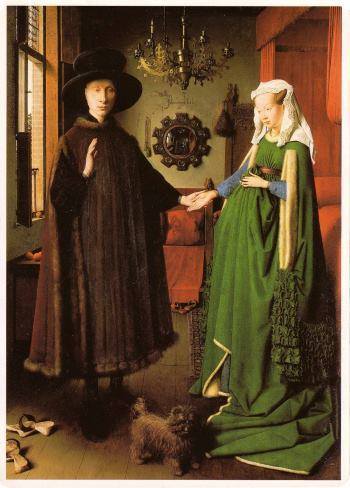 In
the seventeenth century, the church was again affected by works that transformed
the interior, characterized from that moment on by a clear Baroque style. The
Church of San Romano has become part of the history of art, as well as for the
works carried out for it over the centuries, thanks to Giovanni Arnolfini,
the rich merchant and banker of Lucca portrayed in the famous painting by Jan
Van Eyck
Arnolfini Portrait, who died on September 11, 1472, in his will (opened
in Lucca on 10 December 1474) he ordered that the performers should take care of
the foundation of a benefit of a daily mass in the Church of San Romano
(in theory the mass should be celebrated even today, there was no time limit,
but now in the church, which has become an auditorium, no more religious
services are celebrated). The chapter of the church had 400 gold florins of
Lucca, 357 wide ducats and 8 Bolognini as dowries, in land possessions, a very
considerable figure for the time. In
the seventeenth century, the church was again affected by works that transformed
the interior, characterized from that moment on by a clear Baroque style. The
Church of San Romano has become part of the history of art, as well as for the
works carried out for it over the centuries, thanks to Giovanni Arnolfini,
the rich merchant and banker of Lucca portrayed in the famous painting by Jan
Van Eyck
Arnolfini Portrait, who died on September 11, 1472, in his will (opened
in Lucca on 10 December 1474) he ordered that the performers should take care of
the foundation of a benefit of a daily mass in the Church of San Romano
(in theory the mass should be celebrated even today, there was no time limit,
but now in the church, which has become an auditorium, no more religious
services are celebrated). The chapter of the church had 400 gold florins of
Lucca, 357 wide ducats and 8 Bolognini as dowries, in land possessions, a very
considerable figure for the time.
History of the Church of San Romano
 Behind
the Palazzo Ducale in Lucca, the Church of Romano
was the most important Dominican convent in the
city, characterized by an illustrious history,
linked especially between the fifteenth and
sixteenth centuries, close relations with
Girolamo Savonarola and the environment
connected to him. Built in the 13th century, in an
area previously occupied by three sacred buildings,
the church was enlarged at the end of the 14th
century while other more incisive interventions were
undertaken starting from the end of the 15th century
in the climate of general renewal that affected many
city churches, and which culminated with the
installation of two altarpieces by Fra Bartolomeo,
where a dear friend of his was prior to those times,
Saint Pagnini, one with the Madonna of
Mercy, the other with the Eternal with Saint
Catherine and Saint Mary Magdalene. which are
now in the
National Museum of Villa Guinigi. Behind
the Palazzo Ducale in Lucca, the Church of Romano
was the most important Dominican convent in the
city, characterized by an illustrious history,
linked especially between the fifteenth and
sixteenth centuries, close relations with
Girolamo Savonarola and the environment
connected to him. Built in the 13th century, in an
area previously occupied by three sacred buildings,
the church was enlarged at the end of the 14th
century while other more incisive interventions were
undertaken starting from the end of the 15th century
in the climate of general renewal that affected many
city churches, and which culminated with the
installation of two altarpieces by Fra Bartolomeo,
where a dear friend of his was prior to those times,
Saint Pagnini, one with the Madonna of
Mercy, the other with the Eternal with Saint
Catherine and Saint Mary Magdalene. which are
now in the
National Museum of Villa Guinigi.
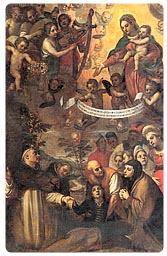 The
tomb of San Romano by Matteo Civitali and the
wooden choir inlaid still on site date back to this
phase. In the first half of the seventeenth century,
proceeded to a further reorganization of the
interior furnishings that involved both the altars
and the related paintings, then entered the church
works of famous painters such as the Sienese
Francesco Vanni, Domenico Cresti said the
Passignano (if you are in Lucca take
advantage to see his Nativity in the
Cathedral of San Martino) and the Caravaggio Paolo Guidotti.
Around the middle of the century there is the most
drastic restructuring campaign suffered by the
church that came to take on that occasion the
structure that still presents today. The
tomb of San Romano by Matteo Civitali and the
wooden choir inlaid still on site date back to this
phase. In the first half of the seventeenth century,
proceeded to a further reorganization of the
interior furnishings that involved both the altars
and the related paintings, then entered the church
works of famous painters such as the Sienese
Francesco Vanni, Domenico Cresti said the
Passignano (if you are in Lucca take
advantage to see his Nativity in the
Cathedral of San Martino) and the Caravaggio Paolo Guidotti.
Around the middle of the century there is the most
drastic restructuring campaign suffered by the
church that came to take on that occasion the
structure that still presents today.
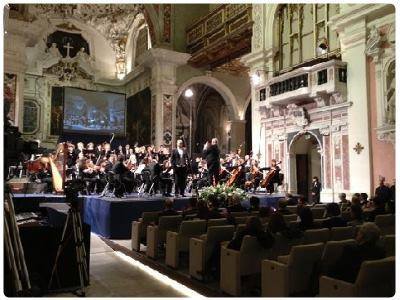 The
precarious conservation conditions of the building
required substantial restoration work, after which
the previous structure was cancelled and
incorporated into the new one. The paintings of the
altars, the result of new commissions, conceal in
many cases the previous installations; the
decoration of the church was completed in the
eighteenth century with interventions in the chapels
and presbyteral area. Indemnified during the
Napoleonic era, the church was stripped of most of
its most precious works, including in particular the
two altarpieces by Fra Bartolomeo today preserved in
the Art Gallery. Never reopened for worship, this
church is now used as a concert hall, suggested by
the two precious organs placed in the nave dating
from the seventeenth century, the other of older
origin but totally tampered with in the nineteenth
century. The
precarious conservation conditions of the building
required substantial restoration work, after which
the previous structure was cancelled and
incorporated into the new one. The paintings of the
altars, the result of new commissions, conceal in
many cases the previous installations; the
decoration of the church was completed in the
eighteenth century with interventions in the chapels
and presbyteral area. Indemnified during the
Napoleonic era, the church was stripped of most of
its most precious works, including in particular the
two altarpieces by Fra Bartolomeo today preserved in
the Art Gallery. Never reopened for worship, this
church is now used as a concert hall, suggested by
the two precious organs placed in the nave dating
from the seventeenth century, the other of older
origin but totally tampered with in the nineteenth
century.
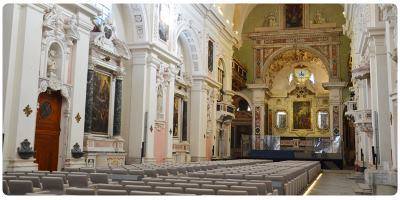 In
recent times the church has been deconsecrated and
now, after heavy restoration work, it serves as an
auditorium. By the way, it is here that many
meetings are held during In
recent times the church has been deconsecrated and
now, after heavy restoration work, it serves as an
auditorium. By the way, it is here that many
meetings are held during
 Lucca Comics.
Lucca Comics.
Copyright ©
Informagiovani-italia.com
Map
1 Memorie del Ducato di Lucca, Volume 4
Di Domenico Bertini
2. Memorie storiche della citta di
Pistoja. -Lucca, Filippo-Maria Benedini 1758
3. Scritti vari del Padre Vincenzo
Marchese Domenicano Le Monnier 1857
Top
Ostelli Lucca
Ostelli Italia
Auberges de Jeunesse Italie
Hotel Lucca
Carte Lucques
Karte von Lucca
Mapa Lucca
Map of Lucca
Carte de
la Toscane Karte
von Toskana Mapa
Toscana Map of
Tuscany
Carte d'Italie
Karte von Italien
Mapa Italia
Map of Italy |